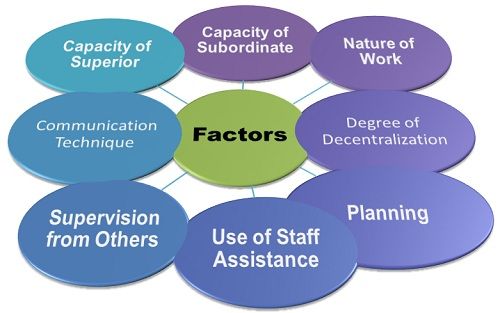Definition: The Span of Management refers to the number of subordinates who report directly to a manager.
Factors Determining Span of Management
The span of management can be determined on the basis of a number of relationships that a manager can manage. These are:
- Capacity of Superior: Here the capacity means the ability of a superior to comprehend the problems quickly and gel up with the staff such that he gets respect from all. Also, the communication skills, decision-making ability, controlling power, leadership skills are important determinants of supervisory capacity. Thus, a superior possessing such capacity can manage more subordinates as compared to an individual who lack these abilities.
- Capacity of Subordinate: If the subordinate is trained and efficient in discharging his functions without much help from the superior, the organization can have a wide span. This means a superior can manage a large number of subordinates as he will be required just to give the broad guidelines and devote less time on each.
- Nature of Work: If the subordinates are required to do a routine job, with which they are well versed, then the manager can have a wider span. But, if the work is complex and the manager is required to give directions, then the span has to be narrower.Also, the change in the policies affects the span of management. If the policies change frequently, then the manager needs to devote more time and hence the span would be narrow whereas if the policies remain stable, then a manager can focus on a large number of subordinates. Likewise, policies technology also plays a crucial role in determining the span.
- Degree of Decentralization: If the manager delegates authority to the subordinates then he is required to give less attention to them. Thus, higher the degree of decentralization, the wider is the span of management. But in case, subordinates do not have enough authority, then the manager is frequently consulted for the clarifications, and as a result superior spends a lot of time in this.
- Planning: If the subordinates are well informed about their job roles, then they will do their work without consulting the manager again and again. This is possible only because of the standing plans that they follow in their repetitive decisions. Through a proper plan, the burden of a manager reduces manifold and can have a wider span of management.
- Staff Assistance: The use of staff assistance can help the manager in reducing his workload by performing certain managerial tasks such as collecting information, processing communications and issuing orders, on his behalf. By doing so, the managers can save their time and the degree of span can be increased
- Supervision from Others: The classical approach to the span of management, i.e., each person should have a single supervisor is changing these days. Now the subordinates are being supervised by other managers in the organization such as staff personnel. This has helped the manager to have a large number of subordinates under him.
- Communication Techniques: The mode of communication also determines the span of management. If in the manager is required to do a face to face communication with each subordinate, then more time will be consumed. As a result, the manager cannot have a wider span. But in case, the communication is in writing and is collected through a staff personnel; the manager can save a lot of time and can have many subordinates under him.
The span of management is also called as the span of supervision or span of control, which influences the complexity of the individual manager’s job and determine the shape or configuration of the organization.


mg says
I was ensed for my engg, economics subject and this is what i was looking for……………..jst amazing explanation.
continue ur good work…
Harry Virk says
Awesome
raj says
very clear cut explanation
masha says
its real impressive i have just learnt same time enjoyed..Great facts….thanks